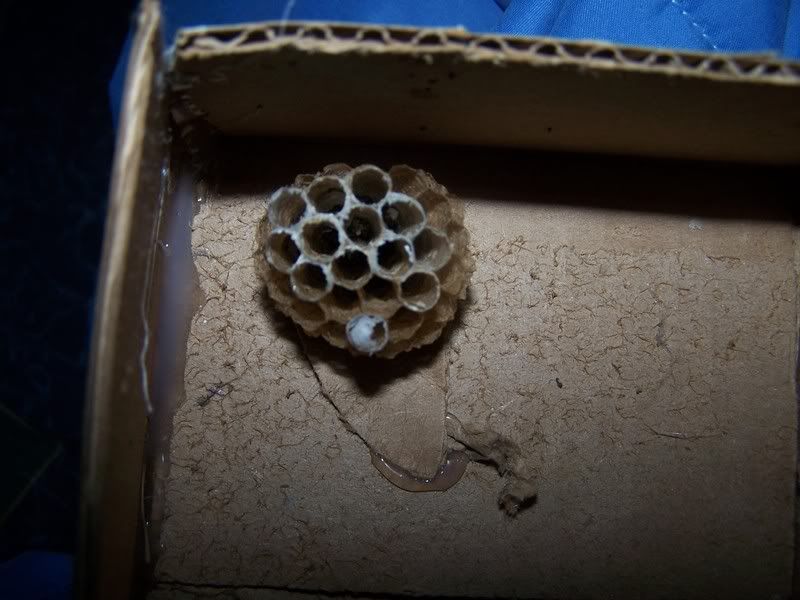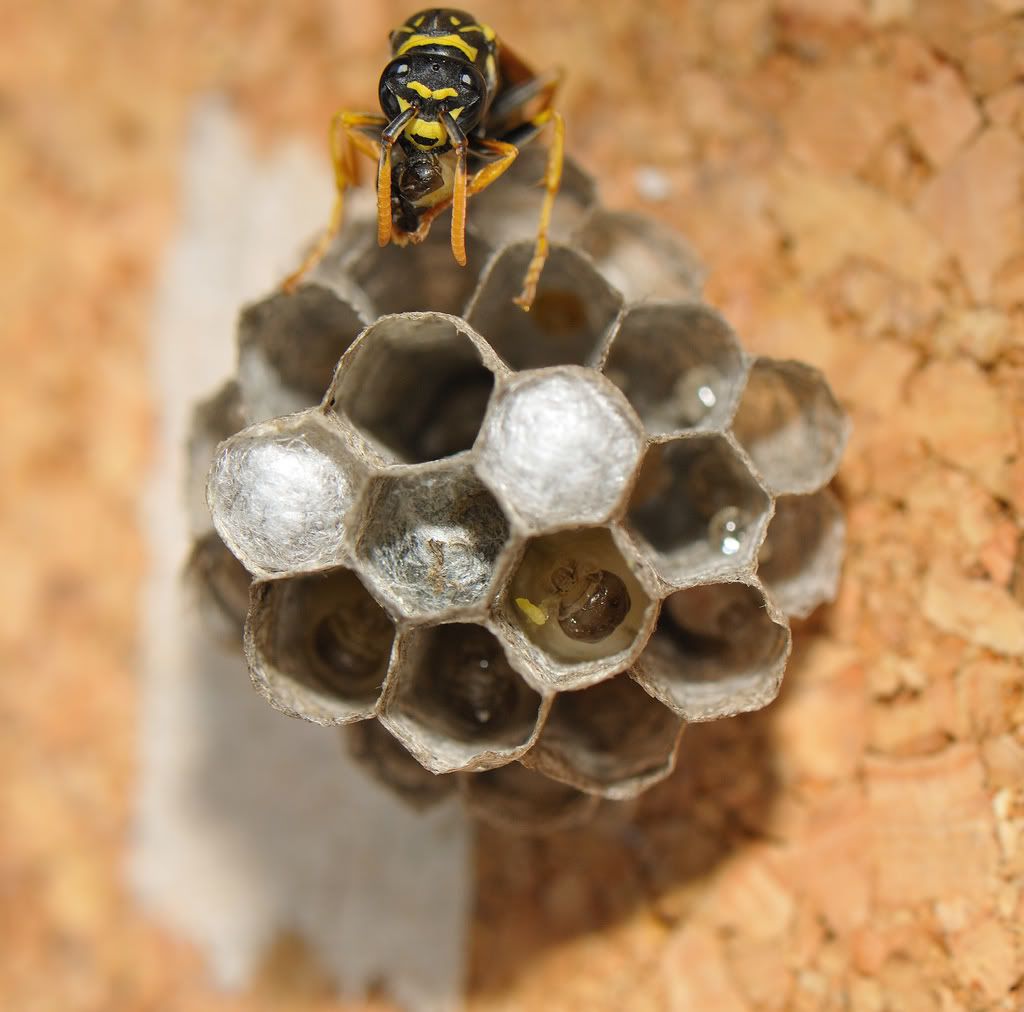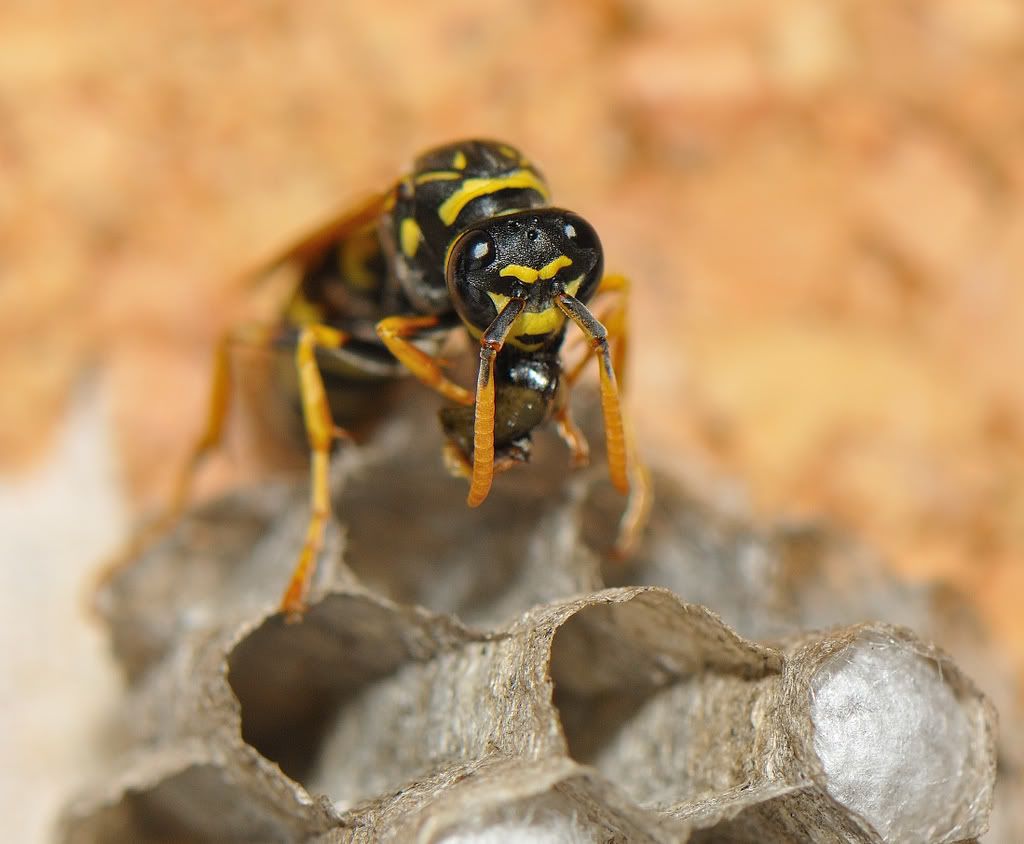- Joined
- Jul 7, 2005
- Messages
- 3,200
This is a follow up to the article I posted last year on wasp keeping, which Tleilaxu and other members also played a huge part. I did make a few mistakes, which I corrected this year...first and foremost being the time of capture.
Last year, I made the mistake of exposing the colony's foundress to direct sunlight for about five minutes during relocation (the drive to my house from the capture site). She never fully recovered and eventually passed away after a few days. The other colony's members did eventually step up, raising the grubs up to adults and building onto the nest. However, none of them laid eggs. I don't know if the Polistes genus is one of those that can't spawn a new queen or if something is required for a worker to make that jump. This is a subject for further research.
The method of capture remains the same as the other article. The only thing that's changed is the time. I captured this nest at night. This foundress decided to build her colony in the same place as the colony I captured last year did.
To capture the foundress, I simply took a super soaker squirt gun and filled it with ice water. The cold immobilized her so she couldn't fly away or sting me. After the foundress or any other possible workers are out of the way, the nest can be safely harvested by hand. The grubs don't sting...but you'll want to make sure the workers are out of the way.
You are going to want to harvest your nest at the beginning of the summer, when the nests are still relatively small. There are two reasons for this.
1.) The nests are still small. You don't have to worry about dozens of angry workers swarming you at once.
2.) The foundress is easily discernable. Generally, the foundress likes to keep her first generation of workers small (she does this by feeding the grubs less) to avoid any struggles for dominance when they emerge. Thus, at the beginning of the summer the foundress will always be the biggest wasp in the nest. If you lose a few workers, it won't matter. However, if you lose the foundress you will have to try again the following night.
Here is the nest I captured:

You can see the grubs and the one cell that's covered up belongs to a grub about to form itself into a pupa.
I'd like to make a special note of this: Generally, the safest time you're going to find to capture the wasp's nest is during the day, when it's easier to see what you're doing. Capturing the colony at night is simply what worked for me the best.
After you're done capturing the colony, it's generally a good idea to refridgerate the foundress for a few minutes. I didn't find this neccesary.
The second thing I'm changing wasn't really a mistake. I found the CD spindle design easy enough to use, but I did have a few problems with escapes that new keepers wouldn't really want to deal with.
This year, I decided to set up the colony in a 5 gallon tank instead of a CD spindle. I especially like this version, it gives me room to observe the colony's interactions with each other and allows easier maintenance. If you're going to use a tank, it's preferable to use a model with a sliding top. We'll get to this later.

If you're working on this late at night (these pictures were taken at like two in the morning) caffine isn't a bad idea because a pissed off vespid will likely be moving faster than you will.
I'd like to thank this guy for letting me finish this project in half an hour, and also keeping me alert enough to not be foolish: (well, kind of)

The next step is to prepare the tank. A lot of people like to keep their wasp nests out in the open surrounded by nothing but clear plastic. This is for visibility.
I don't like to do this. I found my colony last year spent much more time looking at me (we'll get to this behaivior later) than they did interacting amongst themselves. To combat this, I used a modified cardboard box to create sort of a 'fence' (for lack of a better term) around the colony to make them feel safe. You might have to cut a cardboard box to size. Here's how I made mine:
First, I took a box that someone had shipped stuff to me in and cut it like so:

Then, I cut that part off. I then cut two peices off the scraps and glued them to form something that looked like the top half of the box. Here's the result before trimming:

I decided to use cardboard for two reasons.
1.) It might help make their nest. Paper wasps usually like to chew up wood or paper to add on to their nest. This will theoretically supply building materials to help them add to their nests.
2.) Wasps generally use porous materials to attach their nests to. I've never seen a nest on plastic...as of yet. Most of the nests I see are attached to the sides of houses on wooden parts. I even know of one case where wasps built their nest in a fully decomposed human skull. This will seem a bit more natural to them.
The next thing you need to to is set the orientation of the tank. This is something I thought up because I'm a bit anal about this, but you need to be able to work with your wasps with the hand you feel the most comfortable with.
This is how mine is set up:

As you can see, I'm right handed so I prefer my tank's sliding door opens to the left.

When I built the enclosure, I made sure my tank's door opened to the right so I could be certian it would open to the left when I was done.
Next, you want to glue the wasp's nest to the cardboard. This part, I screwed up royally at first:

As you can see, the nest is way too close to the side. You need to leave a little bit of space between the colony and the side of the 'fence'. To correct this, just simply cut the first layer of cardboard off and pull up. You'll get something like this:

Now, please remember when you're dealing with anything that's sharp and pointy at 2 AM that caffine is not a substitute for caution. I did manage to injure myself with the knife I was using:
http://a400.ac-images.myspacecdn.com/images01/127/l_2473954ab59790bfa1a814d680cad36f.jpg
It looks worse than it was.
When you glue the colony, make sure the nest is as vertically orientated as possible. It needs to be straight up and down if you want this to succeed.
Glue the nest and 'fence' in the bottom of the tank upside-down like so:

The result is a polistes enclosure you can comfortably do maintenance in:

Now...the interesting part. Re-introduction of the queen to the nest. Here's the container I used to capture the queen:

Opaque sides are definitely a bonus...especially if you capture your colony during the day.
Anyways...re-introduction of the foundress to the nest isn't the easiest thing in the world. Follow these instructions very carefully...
...One, open the container.

She will climb up to the top of the container like so:

And then, she'll find her nest by smell.

You can't screw it up

She will find her nest on her own. You may need the assistance of a pencil to place her on it, but if the foundress is healthy she will find her own nest without any assistance.
That's it for the housing portion...it's all pretty simple. Now, for the care portion.
Last year, I made the mistake of exposing the colony's foundress to direct sunlight for about five minutes during relocation (the drive to my house from the capture site). She never fully recovered and eventually passed away after a few days. The other colony's members did eventually step up, raising the grubs up to adults and building onto the nest. However, none of them laid eggs. I don't know if the Polistes genus is one of those that can't spawn a new queen or if something is required for a worker to make that jump. This is a subject for further research.
The method of capture remains the same as the other article. The only thing that's changed is the time. I captured this nest at night. This foundress decided to build her colony in the same place as the colony I captured last year did.
To capture the foundress, I simply took a super soaker squirt gun and filled it with ice water. The cold immobilized her so she couldn't fly away or sting me. After the foundress or any other possible workers are out of the way, the nest can be safely harvested by hand. The grubs don't sting...but you'll want to make sure the workers are out of the way.
You are going to want to harvest your nest at the beginning of the summer, when the nests are still relatively small. There are two reasons for this.
1.) The nests are still small. You don't have to worry about dozens of angry workers swarming you at once.
2.) The foundress is easily discernable. Generally, the foundress likes to keep her first generation of workers small (she does this by feeding the grubs less) to avoid any struggles for dominance when they emerge. Thus, at the beginning of the summer the foundress will always be the biggest wasp in the nest. If you lose a few workers, it won't matter. However, if you lose the foundress you will have to try again the following night.
Here is the nest I captured:

You can see the grubs and the one cell that's covered up belongs to a grub about to form itself into a pupa.
I'd like to make a special note of this: Generally, the safest time you're going to find to capture the wasp's nest is during the day, when it's easier to see what you're doing. Capturing the colony at night is simply what worked for me the best.
After you're done capturing the colony, it's generally a good idea to refridgerate the foundress for a few minutes. I didn't find this neccesary.
The second thing I'm changing wasn't really a mistake. I found the CD spindle design easy enough to use, but I did have a few problems with escapes that new keepers wouldn't really want to deal with.
This year, I decided to set up the colony in a 5 gallon tank instead of a CD spindle. I especially like this version, it gives me room to observe the colony's interactions with each other and allows easier maintenance. If you're going to use a tank, it's preferable to use a model with a sliding top. We'll get to this later.

If you're working on this late at night (these pictures were taken at like two in the morning) caffine isn't a bad idea because a pissed off vespid will likely be moving faster than you will.
I'd like to thank this guy for letting me finish this project in half an hour, and also keeping me alert enough to not be foolish: (well, kind of)

The next step is to prepare the tank. A lot of people like to keep their wasp nests out in the open surrounded by nothing but clear plastic. This is for visibility.
I don't like to do this. I found my colony last year spent much more time looking at me (we'll get to this behaivior later) than they did interacting amongst themselves. To combat this, I used a modified cardboard box to create sort of a 'fence' (for lack of a better term) around the colony to make them feel safe. You might have to cut a cardboard box to size. Here's how I made mine:
First, I took a box that someone had shipped stuff to me in and cut it like so:

Then, I cut that part off. I then cut two peices off the scraps and glued them to form something that looked like the top half of the box. Here's the result before trimming:

I decided to use cardboard for two reasons.
1.) It might help make their nest. Paper wasps usually like to chew up wood or paper to add on to their nest. This will theoretically supply building materials to help them add to their nests.
2.) Wasps generally use porous materials to attach their nests to. I've never seen a nest on plastic...as of yet. Most of the nests I see are attached to the sides of houses on wooden parts. I even know of one case where wasps built their nest in a fully decomposed human skull. This will seem a bit more natural to them.
The next thing you need to to is set the orientation of the tank. This is something I thought up because I'm a bit anal about this, but you need to be able to work with your wasps with the hand you feel the most comfortable with.
This is how mine is set up:

As you can see, I'm right handed so I prefer my tank's sliding door opens to the left.

When I built the enclosure, I made sure my tank's door opened to the right so I could be certian it would open to the left when I was done.
Next, you want to glue the wasp's nest to the cardboard. This part, I screwed up royally at first:

As you can see, the nest is way too close to the side. You need to leave a little bit of space between the colony and the side of the 'fence'. To correct this, just simply cut the first layer of cardboard off and pull up. You'll get something like this:

Now, please remember when you're dealing with anything that's sharp and pointy at 2 AM that caffine is not a substitute for caution. I did manage to injure myself with the knife I was using:
http://a400.ac-images.myspacecdn.com/images01/127/l_2473954ab59790bfa1a814d680cad36f.jpg
It looks worse than it was.
When you glue the colony, make sure the nest is as vertically orientated as possible. It needs to be straight up and down if you want this to succeed.
Glue the nest and 'fence' in the bottom of the tank upside-down like so:

The result is a polistes enclosure you can comfortably do maintenance in:

Now...the interesting part. Re-introduction of the queen to the nest. Here's the container I used to capture the queen:

Opaque sides are definitely a bonus...especially if you capture your colony during the day.
Anyways...re-introduction of the foundress to the nest isn't the easiest thing in the world. Follow these instructions very carefully...
...One, open the container.

She will climb up to the top of the container like so:

And then, she'll find her nest by smell.

You can't screw it up

She will find her nest on her own. You may need the assistance of a pencil to place her on it, but if the foundress is healthy she will find her own nest without any assistance.
That's it for the housing portion...it's all pretty simple. Now, for the care portion.
Last edited:


















